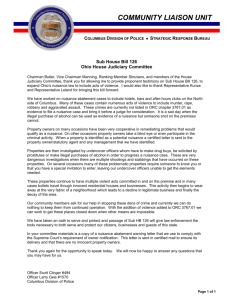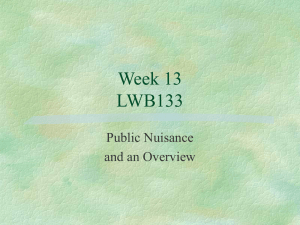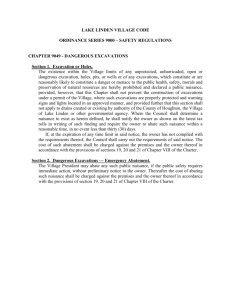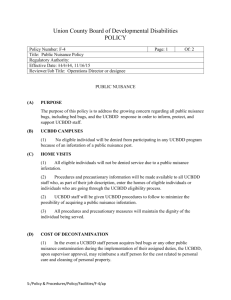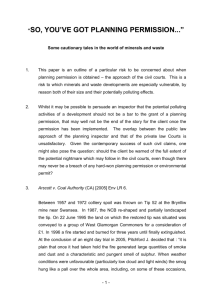Nuisance Question
advertisement
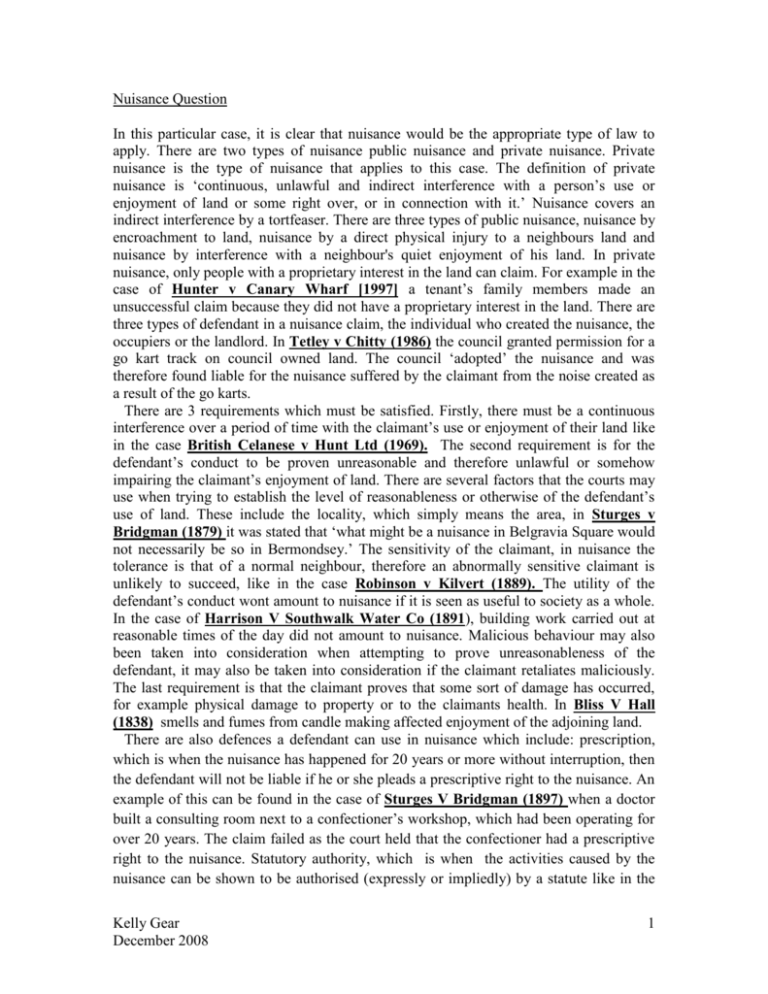
Nuisance Question In this particular case, it is clear that nuisance would be the appropriate type of law to apply. There are two types of nuisance public nuisance and private nuisance. Private nuisance is the type of nuisance that applies to this case. The definition of private nuisance is ‘continuous, unlawful and indirect interference with a person’s use or enjoyment of land or some right over, or in connection with it.’ Nuisance covers an indirect interference by a tortfeaser. There are three types of public nuisance, nuisance by encroachment to land, nuisance by a direct physical injury to a neighbours land and nuisance by interference with a neighbour's quiet enjoyment of his land. In private nuisance, only people with a proprietary interest in the land can claim. For example in the case of Hunter v Canary Wharf [1997] a tenant’s family members made an unsuccessful claim because they did not have a proprietary interest in the land. There are three types of defendant in a nuisance claim, the individual who created the nuisance, the occupiers or the landlord. In Tetley v Chitty (1986) the council granted permission for a go kart track on council owned land. The council ‘adopted’ the nuisance and was therefore found liable for the nuisance suffered by the claimant from the noise created as a result of the go karts. There are 3 requirements which must be satisfied. Firstly, there must be a continuous interference over a period of time with the claimant’s use or enjoyment of their land like in the case British Celanese v Hunt Ltd (1969). The second requirement is for the defendant’s conduct to be proven unreasonable and therefore unlawful or somehow impairing the claimant’s enjoyment of land. There are several factors that the courts may use when trying to establish the level of reasonableness or otherwise of the defendant’s use of land. These include the locality, which simply means the area, in Sturges v Bridgman (1879) it was stated that ‘what might be a nuisance in Belgravia Square would not necessarily be so in Bermondsey.’ The sensitivity of the claimant, in nuisance the tolerance is that of a normal neighbour, therefore an abnormally sensitive claimant is unlikely to succeed, like in the case Robinson v Kilvert (1889). The utility of the defendant’s conduct wont amount to nuisance if it is seen as useful to society as a whole. In the case of Harrison V Southwalk Water Co (1891), building work carried out at reasonable times of the day did not amount to nuisance. Malicious behaviour may also been taken into consideration when attempting to prove unreasonableness of the defendant, it may also be taken into consideration if the claimant retaliates maliciously. The last requirement is that the claimant proves that some sort of damage has occurred, for example physical damage to property or to the claimants health. In Bliss V Hall (1838) smells and fumes from candle making affected enjoyment of the adjoining land. There are also defences a defendant can use in nuisance which include: prescription, which is when the nuisance has happened for 20 years or more without interruption, then the defendant will not be liable if he or she pleads a prescriptive right to the nuisance. An example of this can be found in the case of Sturges V Bridgman (1897) when a doctor built a consulting room next to a confectioner’s workshop, which had been operating for over 20 years. The claim failed as the court held that the confectioner had a prescriptive right to the nuisance. Statutory authority, which is when the activities caused by the nuisance can be shown to be authorised (expressly or impliedly) by a statute like in the Kelly Gear December 2008 1 case of Allen v Gulf oil (1981). Local authority planning permission can also act as a lawful justification in some circumstances if the defendant’s behaviour is otherwise reasonable. A court may use several remedies in a case of nuisance. Abatement, which is the remedy of self-help, i.e. removing over hanging tree branches, which are a nuisance. An injunction may also be used, which has the aim of stopping future acts of nuisance. In the claim between Norman and Emma V Les there is a potential claim as Norman and Emma have proprietary interest in the land and Les is the occupier of the land, which means that he can be sued. The first claim they could make is due to the noise Les has created due to drilling and hammering late over many nights and from the smell coming from the rubbish. This is similar to the cases Halsey v Esso Petroleum (1961) and Bliss v Hall (1838). Both the noise and the smell are indirect acts of nuisance. This claim is for nuisance via interference with a neighbour's quiet enjoyment of his land Les is acting unreasonable by continuously working late and making lots of noise, he is also acting unreasonably by not getting rid of his rubbish that is starting to smell badly. Les has also acted maliciously by not ceasing to work late at night, even after Norman and Emma asked him to. Acts of malice also occurred in Hollywood Silver Fox Farm v Emmett (1936). The case notes also state that Emma and Norman are light sleepers, which is a sign of sensitivity. Sensitivity was also apparent in the Robinson v Kilvert (1889). Cases involving sensitivity are often unsuccessful. However, because Emily is another neighbour who is also being affected by the late night noise this sensitivity is likely to be ignored as ‘normal’ tolerance neighbours are also being affected. Norman and Emily’s claim would be successful. In the second claim of Norman and Emma V Les there is a potential claim as damage to their valuable plants in their garden, like in Mckinnon industries v Walker (1951) where orchids were damaged, was due to paint stripper fumes from rubbish on Les’ property. The fumes indirectly interfere with their enjoyment of the land. Les’ land might be inspected to see if he took reasonable precautions to protect Norman and Emily’s land from any damage. Since the damage has occurred it is unlikely that he did, this is called res ispa loquitur when the thing speaks for itself. This claim is also likely to succeed. Emily also has a potential claim as she too has a proprietary interest in the land. She has also had her enjoyment of the land interfered with due to the noise late at night caused by Les. However, she has retaliated by playing her radio at full blast. This is similar to the case Christie V Davey (1893) where the defendant maliciously made lots of noise to spoil the music lessons taught by the claimant. The court will consider this and will probably perceive this to be a malicious act. Therefore, her claim would fail. Les however, could claim against her, as her actions could be perceived as a nuisance. In conclusion, both or Norman and Emily’s claims are likely to succeed against Les, but Emily’s is highly unlikely to succeed because of her malicious retaliation. As a result of Emily’s malicious retaliation, Les could claim against her. Kelly Gear December 2008 2 Kelly Gear December 2008 3

